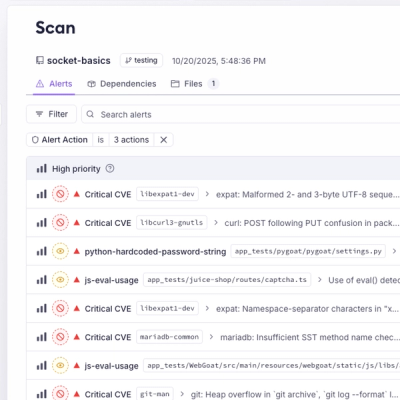
Product
Introducing Webhook Events for Pull Request Scans
Add real-time Socket webhook events to your workflows to automatically receive pull request scan results and security alerts in real time.
bezier-spline
Advanced tools
Creates splines using Bezier curves over an arbitrary number of dimensions.
Creates splines from cubic bezier curves.
This module fits a spline to a set of knots. The curves used are cubic Bezier curves, and the spline is G2 continuous, as this is intended primarily for graphics. C2 continuous splines are a simplification, and may come as an option in future versions.
The theory behind the spline is not documented in the code, as it is too lengthy. Instead, the source code repository contains a .tex file in the theory directory that can be compiled to an explanatory document.
$ npm install bezier-spline
To create a spline, pass in knots. For n knots, n-1 curves will be produced.
const BezierSpline = require('bezier-spline')
let spline = new BezierSpline([
[1, 3],
[0, 4],
[5, 5]
])
You can access the control points of each curve with the curves property. Curves are array-like with 4 elements, which are control points.
let bezier0 = spline.curves[0]
bezier0[0] // The first knot
bezier0[1] // The first generated control point
bezier0[2] // The second generated control point
bezier0[3] // The second knot
console.log(bezier0[0]) // [ 1, 3 ]
These points can then be fed to an api that understands cubic Bezier curves.
A large part of the point of this module is to be able to locate points on the spline by coordinate. For example, if we want to find where the spline above passes through y = 3.14:
spline.getPoints(1, 3.14)
[ [ 0.8369150530498445, 3.1399999999999997 ] ]
Or where x = 0.5:
spline.getPoints(0, 0.5)
[ [ 0.4999999999999999, 3.438251607472109 ],
[ 0.5000000000000002, 4.73728665361036 ] ]
Notably, the results are not exact. We're dealing with lots of floating point addition and inverting functions twice, so this is expected. These splines are not designed for precise mathematics.
Individual curves can be solved similarly if necessary. at plugs in a clamped t value to the cubic Bezier equation.
// Yeah, it's not a very curvy curve, but it makes the math easy
let curve = new BezierSpline.BezierCurve([
[0, 0],
[1, 1],
[2, 2],
[3, 3]
])
curve.at(0.5)
[ 1.5, 1.5 ]
And inversely, you can solve for the t values that correspond to particular values along an axis:
curve.solve(0, 1.5)
[ 0.5 ]
FAQs
Creates splines using Bezier curves over an arbitrary number of dimensions.
The npm package bezier-spline receives a total of 16 weekly downloads. As such, bezier-spline popularity was classified as not popular.
We found that bezier-spline demonstrated a not healthy version release cadence and project activity because the last version was released a year ago. It has 1 open source maintainer collaborating on the project.
Did you know?

Socket for GitHub automatically highlights issues in each pull request and monitors the health of all your open source dependencies. Discover the contents of your packages and block harmful activity before you install or update your dependencies.

Product
Add real-time Socket webhook events to your workflows to automatically receive pull request scan results and security alerts in real time.

Research
The Socket Threat Research Team uncovered malicious NuGet packages typosquatting the popular Nethereum project to steal wallet keys.

Product
A single platform for static analysis, secrets detection, container scanning, and CVE checks—built on trusted open source tools, ready to run out of the box.